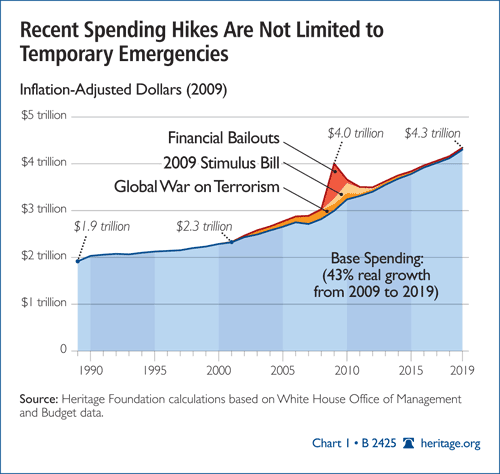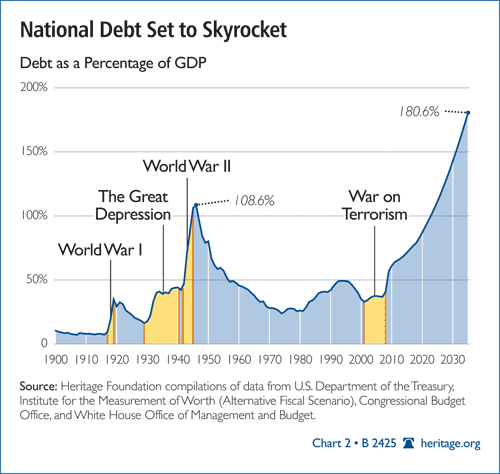Abstract: Long-run federal spending is wildly unsustainable, as almost everyone from right to left agrees. Under President Obama, this long-run problem has been married to an almost equally unsustainable short-run problem of deficit spending. Thus, to watch developments in Europe today is to peer through a clear window into America’s own future. As the nation runs deficits in the Grecian mode and its own public debt soars toward 100 percent of its economy, a future crisis becomes as predictable as the sunrise—and just as widely predicted.
Facing a long-awaited and rapidly building financial contagion, the European Union (EU) announced a massive €750 billion ($956 billion) self-bailout on May 9. This comes on the heels of a previously announced smaller bailout for Greece, Europe’s weakest link financially. The immediate effects of the big package were to provide some stability to the euro, suspend the contagion, and give European leaders time to devise and implement more fundamental changes to their fiscal policies, economic policies, and the very structure of the European economic system.
What the EU bailout did not do was address the underlying causes of the debt crisis. The basic conditions that led to the present state remain. Greece remains a basket case fiscally, politically, and economically—with what an International Monetary Fund (IMF) assessment diplomatically referred to as “deep-rooted vulnerabilities.”[1] Many European nations are running unsustainable budget deficits that debt markets are increasingly reluctant to finance. Even Germany may be at risk due to enormous and as yet unbooked losses from its state-owned Landesbanken.[2] And above all, the reality of Europe’s bankrupting social welfare programs is no longer a matter for future reflection and discussion but is now immediately apparent and demanding of immediate correction. As Czech President Václav Klaus explains, “The European ‘soziale Markwirtshaft’ is an unproductive variant of a welfare state, of state paternalism, of ‘leisure’ society, of high taxes and low motivation to work.”[3]
In many respects, the United States is in an enviably stronger position. While the recent recession was painful, the fundamentals of relatively free markets, relatively low taxes, and a strong and enduring entrepreneurial spirit suggest the economy will return to robust growth despite all the policy bric-a-bracs Washington throws at it. Yet some deeply biting fiscal thorns intrude into this rosy backdrop.
The U.S. is running a massive budget deficit of its own due to an unprecedented surge of spending. (See Chart 1.)
Higher spending is causing the federal government to rapidly build public debt to Grecian levels, all on the way to a rapidly approaching calamity with an unsustainable federal social welfare state modeled on the European tradition.(See Chart 2.)
Failure to reverse the U.S. course on spending— and soon—radically exposes the United States to the same financial and economic problems now facing Europe. The difference is only a matter of time. The correct course is to reverse course on spending to bring deficits back to sustainable levels.

Contagion’s Roots and Branches
The essence of a contagion is that credit markets finally lose faith in a country’s economy, finances, or both. The inherent presumption of credit markets that all will be well one way or another is overturned and replaced with presumptions of distrust and fear. Having abandoned a presumption of faith in one country, markets then cast a critical eye on similarly situated countries. Those found wanting may then face relatively sudden and unexpected pressures, manifested most directly in the reluctance of bond markets to continue to hold and buy a country’s securities at previously normal prices and then at any price—the contagion phase.
In the current event, simple facts suggest why Greece was the natural first spark. According to the IMF’s most recent data, Greece is projected to run a deficit equal to 13.6 percent of gross domestic product (GDP) and already faces total public debt equal to 115 percent of its economy, a figure projected to rise to nearly 150 percent in just a few years.[4] The seeds of the possible contagion are readily apparent in a recent report by the Bank for International Settlements showing that other countries are in similar condition.[5] For example, Portugal’s deficit is projected at 7.6 percent of its economy, but its public debt is approaching 100 percent of GDP. The U.K. is nearly as bad, with a deficit over 13 percent of GDP and debt pushing rapidly toward 100 percent.
However, the true force of contagion goes beyond public finance. It arises from the intense interconnectedness of international finance as underscored by a fascinating graph from The New York Times, which shows the intricate flows of bank liabilities and levels of public debt between five countries at the center of the contagion.[6] As the graph suggests, trouble in Greece can quickly spread to other countries because Greek debt is held as an asset by the banks and investors in these other countries. So when the value of the Greek debt plummets, private balance sheets in other countries deteriorate markedly.

The European Response to Contagion Threats
Recognizing the dangers, European leaders responded in four parts:
- A $76 billion EU balance of payments facility under which the European Commission will issue debt using future EU tax receipts as collateral to help finance members’ severe balance of payments difficulties;
- A system of up to $560 billion in intergovernmental loan guarantees subject to conditions imposed on the borrower by the IMF;
- A commitment by the IMF to use its existing resources to make up to $320 billion in direct loans to troubled countries; and
- A separate but related program by the European Central Bank to purchase stressed public and private debt to ensure the normal functioning of credit markets.
These measures were largely effective in immediately calming markets as market psychology quickly shifted from doubting weak countries to a tentative faith in the willingness and ability of Europe’s leaders to respond to the crisis. However, the credibility of many of the program’s elements has not yet been tested. For example, it is very much an open question whether the German parliament will repeatedly approve the use of German tax dollars for these bailouts. Moreover, in any event the entire program is designed as a short-term financing bridge to give troubled countries time to correct current policy errors and begin to offset previous mistakes. Future government actions by both creditors and debtors will determine how much market forbearance these actions have purchased—and at what price.
What It All Means for the United States
Most immediately, the European mega bailout has produced a moment of relative calm. As uncertainties built in Europe, a large and growing uncertainty premium was building in financial markets. This was readily apparent in European equity and bond markets and in the sinking value of the euro. It was also apparent in sliding U.S. equity markets. It was less apparent in U.S. bond markets, as worries about Europe led to the predicted surge of flight-to-quality capital flows into the U.S. from abroad, driving down bond rates. The European bailout has allowed much of this uncertainty premium to dissipate for the moment and so global markets found a more normal footing.
Near-term stabilization in Europe also means the European recovery should continue for a period, which means in turn that U.S. exports to Europe should follow their normal course, though there will be negative effects on the net trade deficit with Europe from a stronger dollar vis-à-vis the euro. In contrast, if the European contagion had swept the continent, or if it does yet, the European recovery would falter and the U.S. net trade deficit with Europe would balloon. So for the U.S., score two bullets dodged.
Most important by far, however, is the big story. The U.S. has been episodically following the European model of massive government spending built around a high-tax social welfare state—the very system President Klaus warns about—but fortunately the U.S. has until recently lagged Europe by some decades. Under President Obama, the United States has been in a big rush to catch up through enormous increases in entitlement and non-entitlement spending, pushing spending from the normal levels of about 20 percent of GDP to 26 percent and higher.
We have now seen first in Greece—but inexorably also in the United Kingdom and then even eventually in Germany and France—the collapse of the European model. As The Washington Post presciently observed, the conditions attached to any bailout loans mean that “European governments will rewrite a post-World War II social contract that has been generous to workers and retirees but has become increasingly unaffordable for an aging population.”[7]
The essential problem with the European model is that the underlying grand bargain is not a static one. The grand bargain is an exchange of high economic growth and robust individual freedom for expectations of greater economic stability and security provided by an ever-more omnipresent government. Over time, the consequence of a dismissive attitude toward the forces necessary for economic growth is ever-less growth. Over time, the consequence of a more permissive attitude toward governmental beneficence is more and more government while the taxation necessary to support that level of government falls increasingly short.
Only Two Solutions
Long-run federal spending is wildly unsustainable, as almost everyone from right to left agrees. Under President Obama, this long-run problem has been married to an almost equally unsustainable short-run problem of deficit spending. Thus, to watch developments in Europe today is to peer through a clear window into America’s own future. As the nation runs deficits in the Grecian mode and its own public debt soars toward 100 percent of its economy, a future crisis becomes as predictable as the sunrise—and just as widely predicted.
The issue is a simple one. Federal receipts will soon return to normal, but they will be inadequate to reduce budget deficits to sustainable levels because federal spending has exploded. One solution is to raise taxes massively, adopting the European high-tax social welfare model and accept permanently lower wages and incomes before and after tax. The other is to return spending to historical levels and enjoy both more freedom and a stronger economy. The right solution is to choose freedom.
—J. D. Foster, Ph.D., is Norman B. Ture Senior Fellow in the Economics of Fiscal Policy in the Thomas A. Roe Institute for Economic Policy Studies at The Heritage Foundation.

